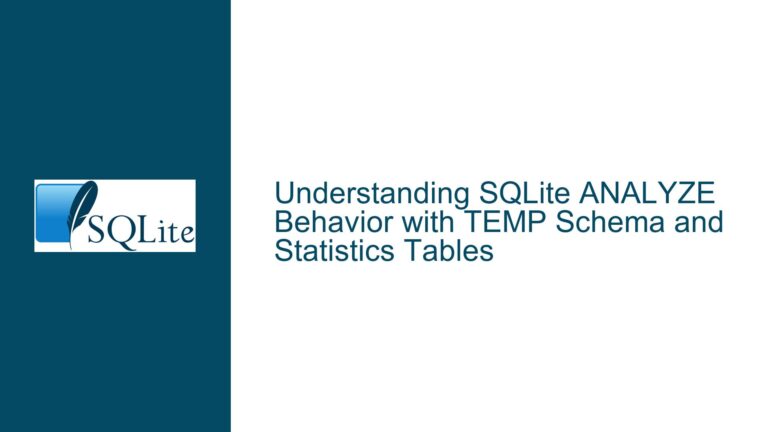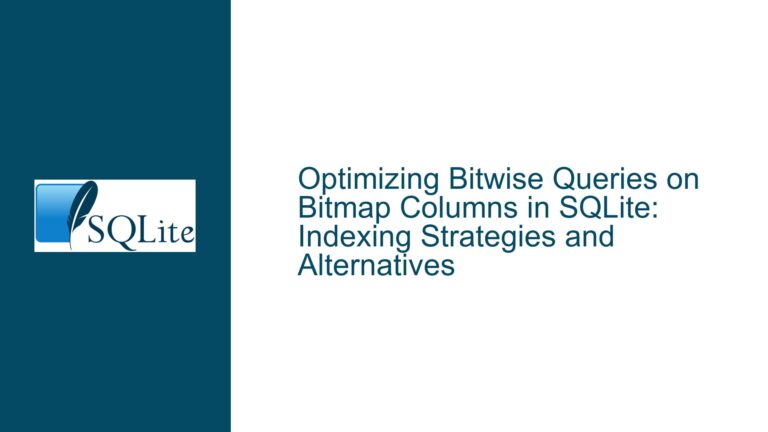and Fixing Bloom Filter Blob Capacity Underutilization in SQLite
Bloom Filter Blob Capacity Underutilization in SQLite
Issue Overview
The core issue revolves around the underutilization of the bloom filter blob capacity in SQLite, specifically in the context of how the bloom filter hashing mechanism is implemented. Bloom filters are probabilistic data structures used to test whether an element is a member of a set. They are particularly useful in databases for optimizing query performance by reducing the number of disk accesses required to check for the existence of a record. In SQLite, the bloom filter is implemented using a blob (binary large object) that stores a bit array. The size of this blob is determined by the estimated number of rows in the table, and it is initialized to a minimum size of 10,000 bytes (80,000 bits) to ensure sufficient capacity for the filter.
The problem arises in the way the bloom filter is populated and accessed. The bloom filter is populated by setting specific bits in the blob based on the hash values of the elements being added to the filter. The hash value is computed using a hashing function, and the resulting value is then used to determine which bit in the blob should be set. However, due to the way the modulo operation is applied to the hash value, only a fraction of the available bits in the blob are ever used. Specifically, when the bloom filter is initialized to its minimum size of 10,000 bytes, only the first 1,250 bytes (10,000 bits) of the blob are ever accessed, leaving the remaining 8,750 bytes (70,000 bits) unused. This underutilization of the bloom filter capacity leads to a higher probability of false positives, which can degrade query performance.
The false positive rate of a bloom filter is a critical metric that determines its effectiveness. A higher false positive rate means that the filter is more likely to incorrectly indicate that an element is a member of the set when it is not. In the context of SQLite, this could result in unnecessary disk accesses and slower query performance. The ideal false positive rate for a bloom filter is around 11.75%, but due to the underutilization of the blob capacity, the actual false positive rate in this case increases to 63.2%. This significant increase in the false positive rate undermines the purpose of using a bloom filter for query optimization.
Possible Causes
The root cause of the bloom filter blob capacity underutilization lies in the implementation details of the bloom filter hashing mechanism in SQLite. Specifically, the issue stems from the way the hash value is processed to determine which bit in the blob should be set. The hash value is computed using a hashing function, and the resulting value is then subjected to a modulo operation to ensure that it falls within the range of the blob’s size. However, the modulo operation is applied in a way that only a fraction of the blob’s capacity is ever utilized.
In the code snippet provided, the hash value h is computed using the filterHash function, and then the modulo operation h %= pIn1->n is applied to ensure that h falls within the range of the blob’s size. Here, pIn1->n represents the size of the bloom filter blob in bytes. For a blob size of 10,000 bytes, the modulo operation ensures that h can only take values between 0 and 9,999. However, when the bit position is calculated using pIn1->z[h/8], only the first 1,250 bytes (10,000 bits) of the blob are ever accessed. This is because the division by 8 in the expression h/8 effectively limits the range of bytes that can be addressed to the first 1,250 bytes, leaving the remaining 8,750 bytes unused.
This limitation arises because the modulo operation is applied to the hash value before the bit position is calculated. As a result, the hash value is constrained to a range that is smaller than the actual size of the blob, leading to the underutilization of the blob’s capacity. This design flaw in the bloom filter implementation results in a higher false positive rate, which can negatively impact query performance.
Another potential cause of the issue is the way the bloom filter size is determined. The size of the bloom filter is initially set based on the estimated number of rows in the table, with a minimum size of 10,000 bytes. However, the size of the bloom filter may not be adjusted dynamically based on the actual number of elements being added to the filter. This static sizing approach can lead to inefficiencies in the bloom filter’s operation, particularly if the actual number of elements is significantly smaller than the estimated number of rows. In such cases, the bloom filter may be larger than necessary, but due to the underutilization issue, it may still suffer from a high false positive rate.
Troubleshooting Steps, Solutions & Fixes
To address the issue of bloom filter blob capacity underutilization in SQLite, several steps can be taken to ensure that the bloom filter operates efficiently and with an optimal false positive rate. The following troubleshooting steps and solutions outline the necessary changes to the bloom filter implementation to resolve the issue.
Modify the Hash Value Processing Logic: The primary issue lies in the way the hash value is processed to determine the bit position in the bloom filter blob. To ensure that the entire blob capacity is utilized, the modulo operation should be applied after the bit position is calculated, rather than before. This can be achieved by modifying the code in the
OP_FilterAddandOP_Filtercases in the SQLite virtual machine (VM) implementation. Specifically, the hash valuehshould be used directly to calculate the bit position, and the modulo operation should be applied to the resulting bit position to ensure that it falls within the range of the blob’s size. This change will allow the bloom filter to utilize the entire blob capacity, reducing the false positive rate to the desired level.Adjust the Bloom Filter Size Calculation: The size of the bloom filter should be calculated based on the actual number of elements being added to the filter, rather than relying solely on the estimated number of rows in the table. This can be achieved by dynamically adjusting the bloom filter size as elements are added. For example, if the number of elements exceeds the capacity of the current bloom filter, the filter size can be increased to accommodate the additional elements. This dynamic sizing approach will ensure that the bloom filter is appropriately sized for the actual workload, reducing the likelihood of underutilization and improving query performance.
Optimize the Hashing Function: The hashing function used to compute the hash value
hplays a critical role in the effectiveness of the bloom filter. To minimize the probability of hash collisions and reduce the false positive rate, the hashing function should be optimized to produce a uniform distribution of hash values. This can be achieved by using a high-quality hashing algorithm, such as MurmurHash or CityHash, which are known for their excellent distribution properties. Additionally, multiple independent hash functions can be used to further reduce the probability of false positives. By combining the results of multiple hash functions, the bloom filter can achieve a lower false positive rate while utilizing the entire blob capacity.Implement Bloom Filter Compression: In cases where the bloom filter size is large, it may be beneficial to implement bloom filter compression techniques to reduce the memory footprint of the filter. Compressed bloom filters can store the same amount of information in a smaller space, allowing for more efficient use of memory and potentially reducing the false positive rate. Techniques such as Golomb coding or arithmetic coding can be used to compress the bloom filter while maintaining its effectiveness. This approach is particularly useful in scenarios where memory usage is a concern, such as in embedded systems or mobile devices.
Test and Validate the Changes: After implementing the above changes, it is essential to thoroughly test and validate the modified bloom filter implementation to ensure that it operates as expected. This includes testing the bloom filter with various workloads and data sets to verify that the false positive rate is within the desired range. Additionally, performance testing should be conducted to ensure that the changes do not introduce any significant overhead or degrade query performance. Any issues identified during testing should be addressed before deploying the modified bloom filter implementation in a production environment.
Monitor and Tune the Bloom Filter: Once the modified bloom filter implementation is deployed, it is important to monitor its performance and make any necessary adjustments to ensure optimal operation. This includes monitoring the false positive rate, memory usage, and query performance to identify any potential issues. If the false positive rate is still higher than desired, further tuning of the bloom filter parameters, such as the size or the number of hash functions, may be necessary. Regular monitoring and tuning will help maintain the effectiveness of the bloom filter and ensure that it continues to provide the desired performance benefits.
By following these troubleshooting steps and implementing the necessary changes, the issue of bloom filter blob capacity underutilization in SQLite can be effectively resolved. The modified bloom filter implementation will utilize the entire blob capacity, resulting in a lower false positive rate and improved query performance. Additionally, the dynamic sizing and optimization techniques will ensure that the bloom filter operates efficiently across a wide range of workloads and data sets.






